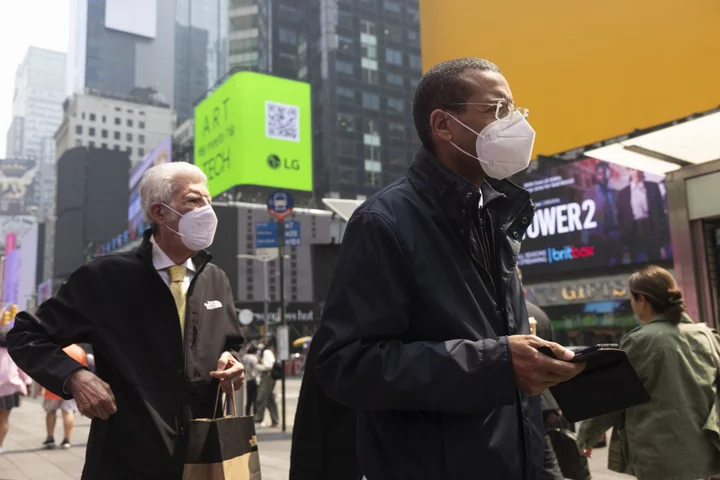The number of wildfires burning in Canada’s top energy-producing province of Alberta is on the rise again, hurting air quality across the region and threatening oil and gas production.
The province had 76 active wildfires, up from 71 on Friday, with 23 burning out of control, according to provincial data on Monday. Smoke from the blazes — which are most active in the central and western parts of the province — was set to drift south to Calgary on Monday and Tuesday, worsening the air quality into the “high risk” category, according to Environment Canada.
Some relief is expected in the coming days, with rain and cooler weather set to help firefighters, Alberta Wildfire spokeswoman Melissa Story said at a press conference Monday. The amount of land burned has risen to a record 1.4 million hectares in the province, she said.
The epicenter of the fires is a major region for natural gas and light oil production, and infernos in the area earlier this year shut down significant amounts of output. On Saturday, TC Energy Corp. shut two compressor stations that were part of its NOVA Gas Transmission system and a gas-storage facility that were close to wildfires in the Edson area. Cooler weather and rain is expected
“If you look at Western Canada, it’s completely covered by the smoke,” Gerald Cheng, a meteorologist with Environment Canada, said in a media briefing. Edmonton, Alberta, and Saskatoon, Saskatchewan, also reported unhealthy air quality, and the haze could remain over parts of both provinces into Wednesday, Cheng said.
Across Canada, there are currently 431 wildfires burning, of which 208 are out of control, Emergency Preparedness Minister Bill Blair told reporters. Nearly 30,000 people remain evacuated and 47,000 square kilometers (11.6 million acres) of land have been burned, he said.
“This now qualifies, unfortunately, as Canada’s worst wildfire season of the 21st century,” Blair said. The Canadian Armed Forces are helping in the hardest-hit areas in Alberta, Quebec and Nova Scotia, and thousands of firefighters, including nearly 1,100 crew members from other countries, have been deployed across Canada. Crews from Portugal and Spain will be arriving soon, he said.
In Quebec, where fires sent thick smoke across the US eastern seaboard last week, the situation has improved, but there were still 113 active blazes as of Monday afternoon. That’s down from about 150 late last week.
Some rain is expected in southern Quebec over the next two days, but the amount is not likely to be significant, and there is a chance of lightning, which can ignite fires, Environment Canada’s Cheng said. There is no rainfall in the forecast for northwestern Ontario until the weekend. The most significant wildfires are still producing a lot of smoke, he said.
Read More: US, Canada Cities Risk Smoke as Fires Still Burn: Weather Watch
Current wind flows around those provinces are funneling pollution north. But a low-pressure system is forming over the Great Lakes, and that “is looking to act as a tap to bring more smoke,” said Bob Oravec, a senior branch forecaster at the US Weather Prediction Center. Late spring has been marked by systems that have kept conditions cool and helped push smoke from Quebec’s forests across the urban areas of Canada and the US.
“As long as those fires are still burning, there are going to be chances for some kind of smoke coming south,” Oravec said.
Sean Fraser, the immigration minister who represents a district in Nova Scotia, said the scenes on the ground of a large wildfire near Halifax have been “apocalyptic, frankly.” The fire destroyed about 200 buildings, including 150 homes, and many people remain displaced.
“Thanks to the extraordinary work of our firefighters, including a significant number of volunteer firefighters, no one yet has perished in Nova Scotia as a result of the disaster,” Fraser said.
--With assistance from Robert Tuttle and Brian K. Sullivan.
(Updates with rain forecast in third paragraph)

